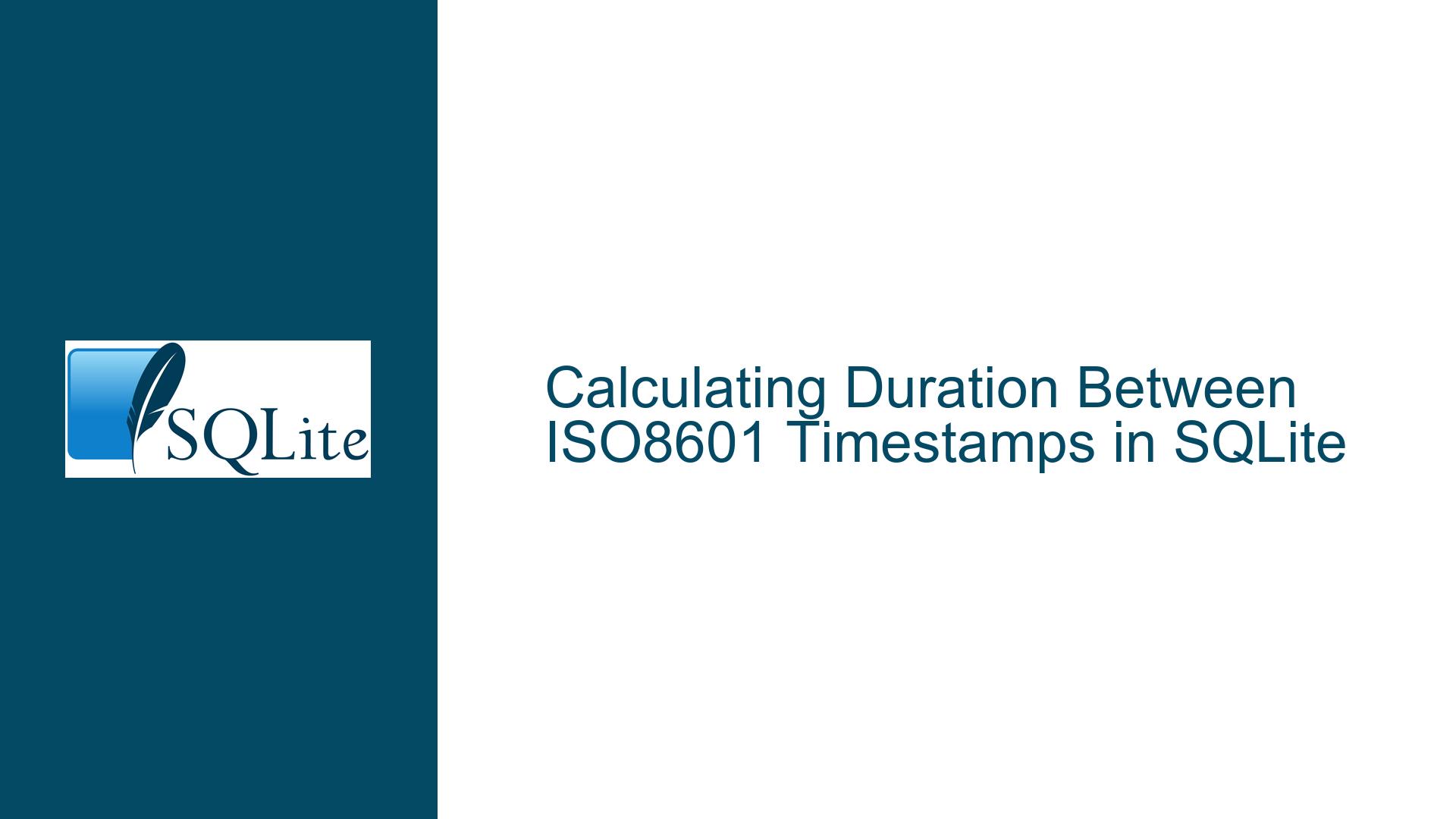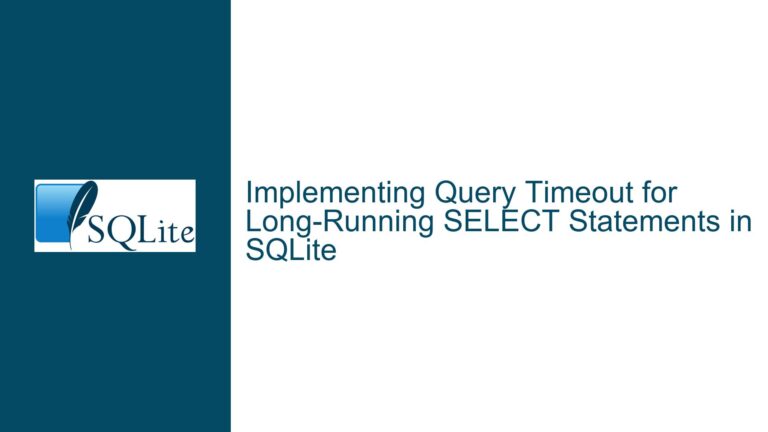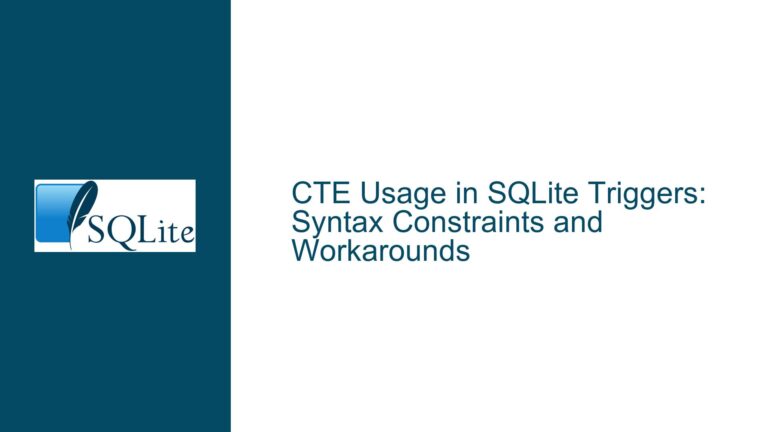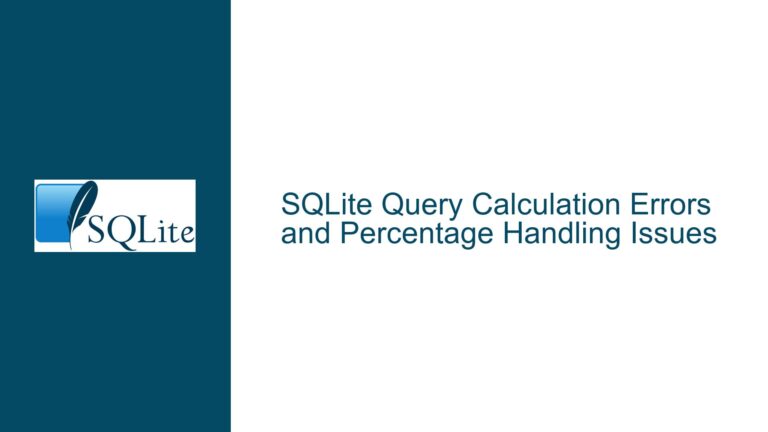Calculating Duration Between ISO8601 Timestamps in SQLite
Timestamp Formatting and julianday Function Behavior
Issue Overview
The core challenge revolves around accurately calculating the duration between two timestamp values stored as text in SQLite, where initial attempts produced null/zero results. The timestamps provided used colons as separators between seconds and fractional seconds (e.g., 2021-07-19 08:43:46:956), which violates SQLite’s datetime parsing rules. Three critical elements converge here:
- DateTime String Compliance: SQLite’s date/time functions require strict adherence to ISO8601 formatting rules. The use of colons instead of periods in fractional seconds violates these requirements, causing parsing failures.
- Column Referencing Errors: Misuse of quotation marks around column names in function calls led to literal string processing rather than column value evaluation.
- julianday Calculation Nuances: Proper usage of the
julianday()function depends on both valid timestamp formats and correct column/value referencing.
These factors created compounding errors where duration calculations returned null or zero despite valid timestamps in human-readable form. The issue was further obscured by inconsistent datetime formatting attempts across multiple query variations.
Timestamp Parsing Limitations and Syntax Errors
Fractional Second Format Mismatch
SQLite’s datetime functions interpret only specific timestamp formats. The critical requirement for fractional seconds is a period (.) separator, not a colon (:). A timestamp like2021-07-19 08:43:46:956is invalid because:- The
julianday()function stops parsing at the first non-numeric/non-period character after seconds. - This results in silent parsing failures, where invalid timestamps return
NULLwithout explicit errors.
- The
Column Name vs. String Literal Confusion
Wrapping column names in single quotes (e.g.,julianday('datetime')) caused SQLite to interpret'datetime'as a string literal instead of referencing thedatetimecolumn. This mistake:- Forced
julianday()to operate on the literal text "datetime", which is not a valid timestamp. - Produced null values for all calculations involving the misquoted column.
- Forced
Inadequate String Manipulation
Attempts to reformat timestamps usingstrftime()failed due to:- Incorrect format specifiers (e.g.,
%S.%fvs.%S:%f). - Lack of intermediate string processing to replace colons with periods in fractional seconds.
- Incorrect format specifiers (e.g.,
Time Zone Ambiguity
While not directly causing calculation failures, the absence of time zone indicators (e.g.,Zor+HH:MM) introduced potential future errors when comparing timestamps across different zones.
Data Correction and Query Refinement Strategies
Step 1: Validate and Repair Timestamp Formats
Objective: Ensure all timestamp values comply with SQLite’s datetime parsing rules.
Action 1a: Batch Update Existing Data
If existing timestamps use colons in fractional seconds, execute an update to replace the final colon with a period:
UPDATE table1
SET datetime = substr(datetime, 1, 19) || '.' || substr(datetime, 21, 3)
WHERE datetime LIKE '%:%:%';
This splits the timestamp at the 19th character (end of seconds), replaces the colon with a period, and appends the fractional seconds.
Action 1b: Enforce Correct Format at Insertion
Modify the application generating timestamps to use periods in fractional seconds:
# Python example for generating SQLite-compatible timestamps
from datetime import datetime
timestamp = datetime.now().strftime("%Y-%m-%d %H:%M:%S.%f")[:-3] # Truncate to 3 fractional digits
Step 2: Calculate Duration Using julianday()
Objective: Compute accurate duration between timestamps once data is formatted correctly.
Query 2a: Basic Duration in Days
SELECT
MIN(datetime) AS start,
MAX(datetime) AS end,
julianday(MAX(datetime)) - julianday(MIN(datetime)) AS duration_days
FROM table1;
Output Interpretation:
duration_days: Fractional days between timestamps (e.g., 1.07146 days).
Query 2b: Duration in Seconds
Multiply the julianday() difference by 86400 (seconds/day):
SELECT
(julianday(MAX(datetime)) - julianday(MIN(datetime))) * 86400 AS duration_seconds
FROM table1;
Step 3: Handle Legacy Data with Colons in Queries
Objective: Calculate durations without modifying existing data.
Query 3a: On-the-Fly Timestamp Correction
Use string functions to replace the final colon with a period:
SELECT
julianday(
substr(datetime, 1, 19) || '.' || substr(datetime, 21, 3)
) AS corrected_julianday
FROM table1;
Query 3b: Full Duration Calculation with Correction
SELECT
(julianday(
substr(MAX(datetime), 1, 19) || '.' || substr(MAX(datetime), 21, 3)
) -
julianday(
substr(MIN(datetime), 1, 19) || '.' || substr(MIN(datetime), 21, 3)
)) * 86400 AS duration_seconds
FROM table1;
Step 4: Formatting Output for Human Readability
Objective: Convert fractional day results into DD:HH:MM:SS.SSS format.
Query 4a: Using strftime and Modulo Operations
WITH durations AS (
SELECT
julianday(MAX(datetime)) - julianday(MIN(datetime)) AS days
FROM table1
)
SELECT
days || ' days' AS total_days,
printf('%02d:%02d:%02d.%03d',
CAST((days * 24) AS INTEGER),
CAST((days * 24 * 60) % 60 AS INTEGER),
CAST((days * 24 * 60 * 60) % 60 AS INTEGER),
CAST((days * 24 * 60 * 60 * 1000) % 1000 AS INTEGER)
) AS formatted_duration
FROM durations;
Step 5: Time Zone Handling
Objective: Avoid errors when timestamps originate from different time zones.
Action 5a: Normalize to UTC
Modify timestamps to include a Z suffix (UTC) or offset:
-- Convert local time to UTC during insertion
INSERT INTO table1 (datetime)
VALUES (datetime('now', 'utc'));
Query 5b: Duration Across Time Zones
When dealing with mixed offsets:
SELECT
(julianday(
substr(MAX(datetime), 1, 19) || '.' || substr(MAX(datetime), 21, 3)
) -
julianday(
substr(MIN(datetime), 1, 19) || '.' || substr(MIN(datetime), 21, 3)
)) * 86400 AS duration_seconds
FROM table1;
Advanced Solution: User-Defined Functions (UDFs)
For environments where SQLite extensions are permissible, implement a custom function to handle non-standard timestamps.
Code Snippet: elapsedTime UDF
Register a UDF to parse colon-separated fractional seconds:
#include <sqlite3ext.h>
SQLITE_EXTENSION_INIT1
static void elapsedTime(
sqlite3_context *context,
int argc,
sqlite3_value **argv
) {
const char *input = (const char*)sqlite3_value_text(argv[0]);
// Custom parsing logic for 'YYYY-MM-DD HH:MM:SS:SSS' format
// ... (implementation as per discussion thread)
}
// Register UDF
int sqlite3_extension_init(
sqlite3 *db,
char **pzErrMsg,
const sqlite3_api_routines *pApi
) {
SQLITE_EXTENSION_INIT2(pApi);
sqlite3_create_function(db, "elapsedTime", 1, SQLITE_UTF8, 0, elapsedTime, 0, 0);
return SQLITE_OK;
}
Usage Example
SELECT
elapsedTime(max_datetime - min_datetime) AS duration
FROM table1;
Final Recommendations
- Data Hygiene: Store timestamps as
YYYY-MM-DD HH:MM:SS.SSSwith UTC indicators. - Validation Constraints: Add CHECK constraints to enforce valid formats:
CREATE TABLE table1 ( datetime TEXT CHECK (datetime LIKE '____-__-__ __:__:__.___') ); - Indexing: Create indexes on datetime columns for efficient MIN/MAX queries:
CREATE INDEX idx_table1_datetime ON table1(datetime);
By methodically addressing timestamp formatting, column referencing, and calculation methodology, robust duration calculations become achievable in SQLite without resorting to external tools or complex workarounds.






